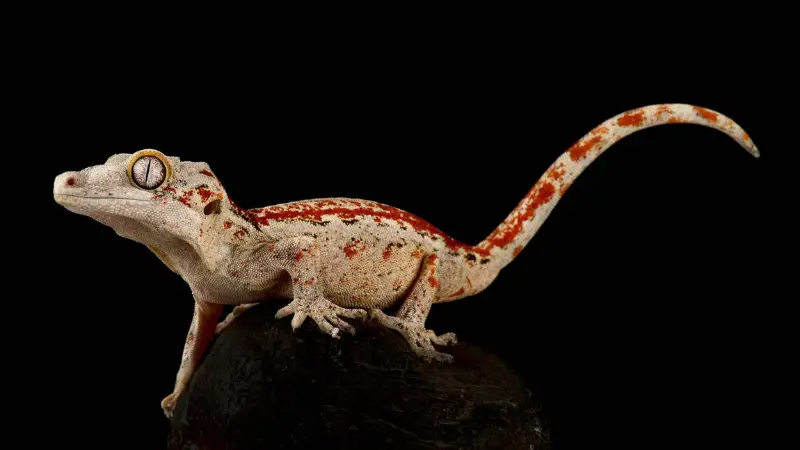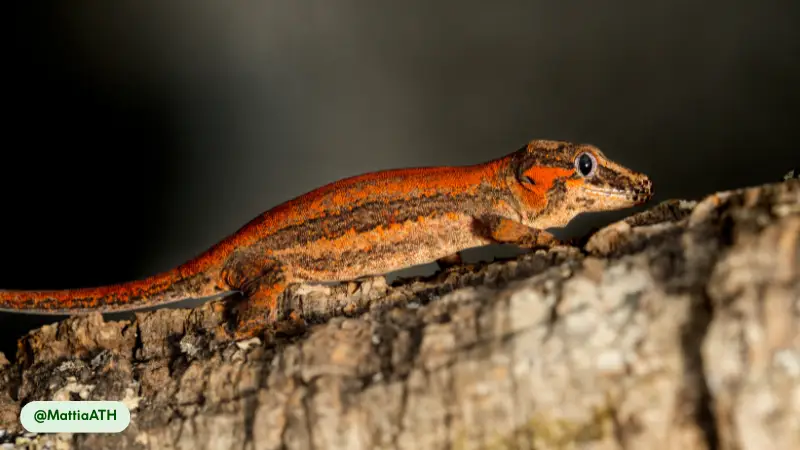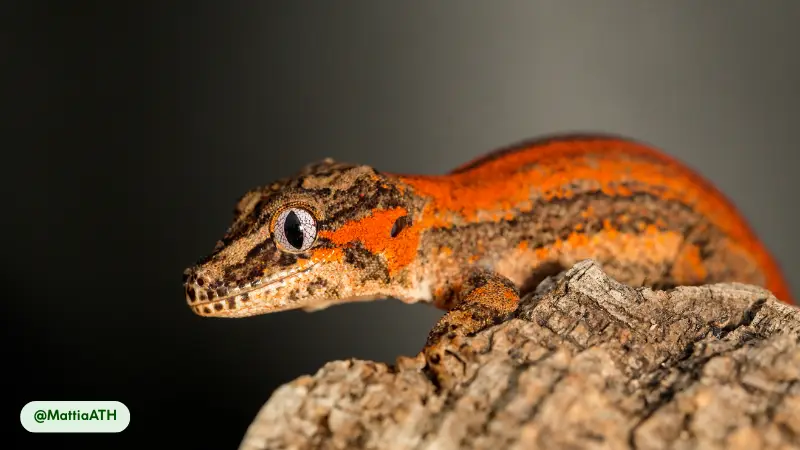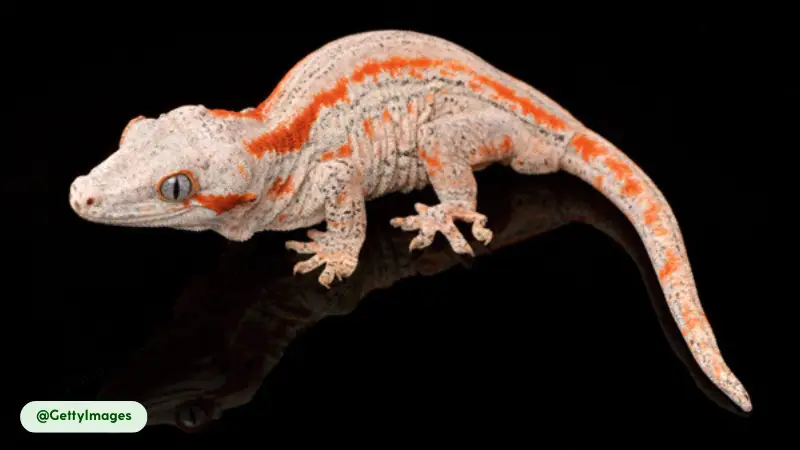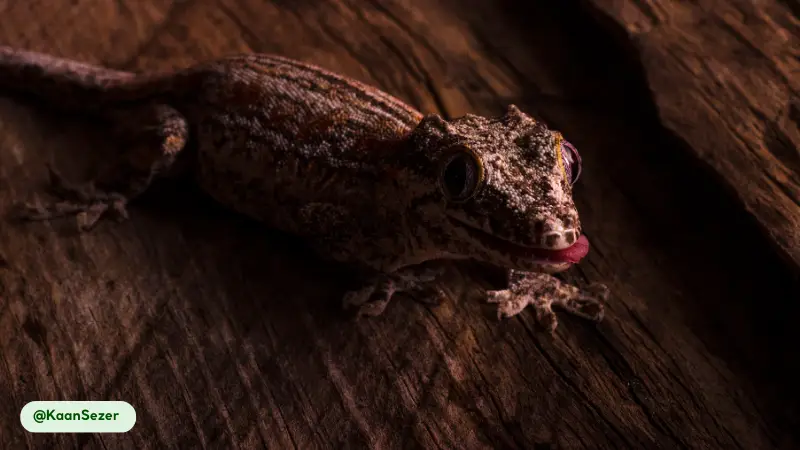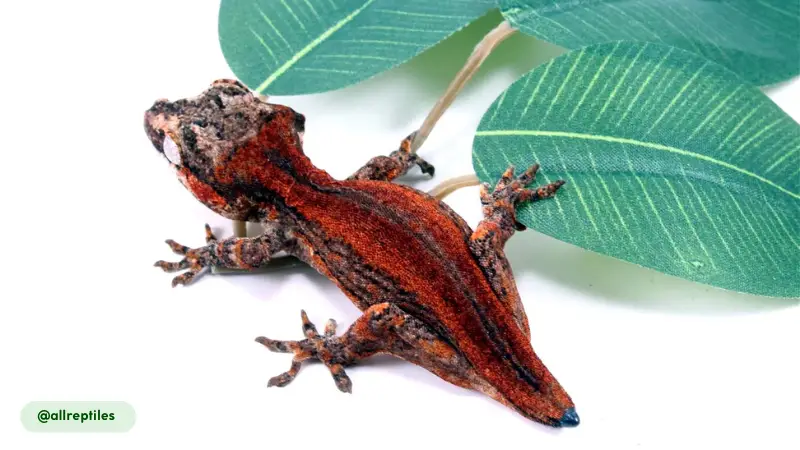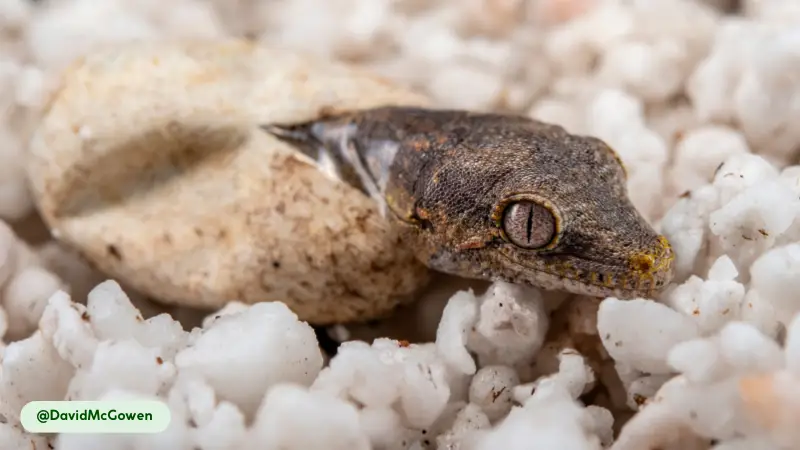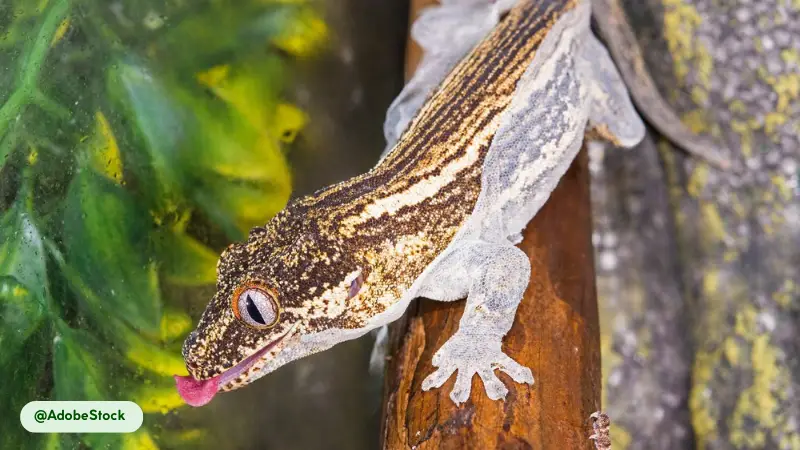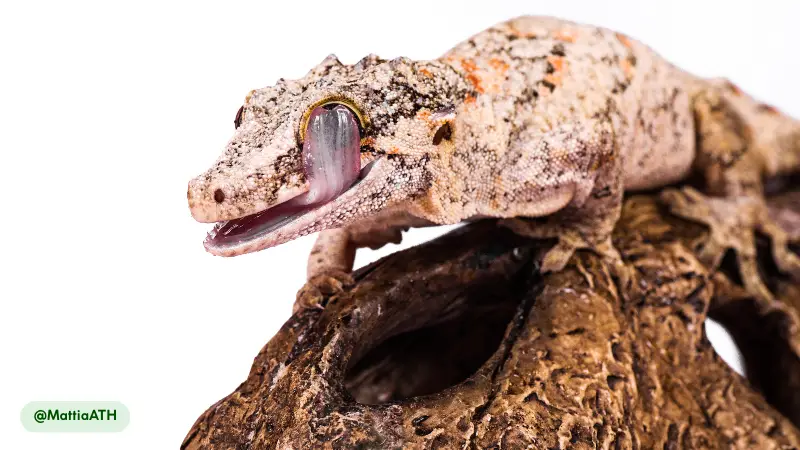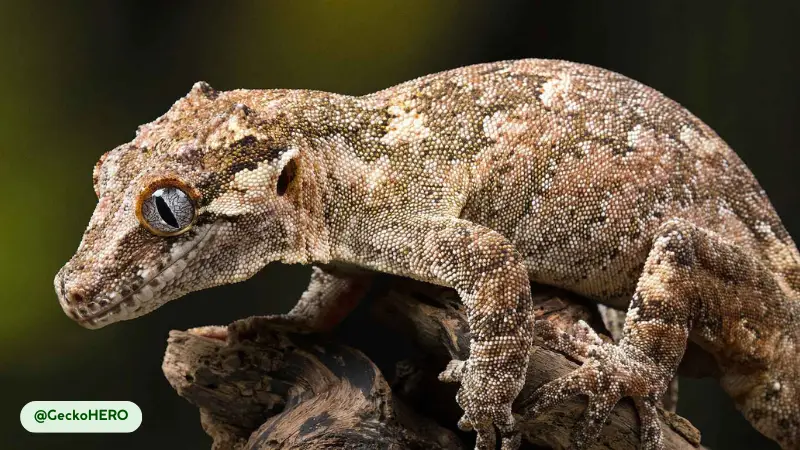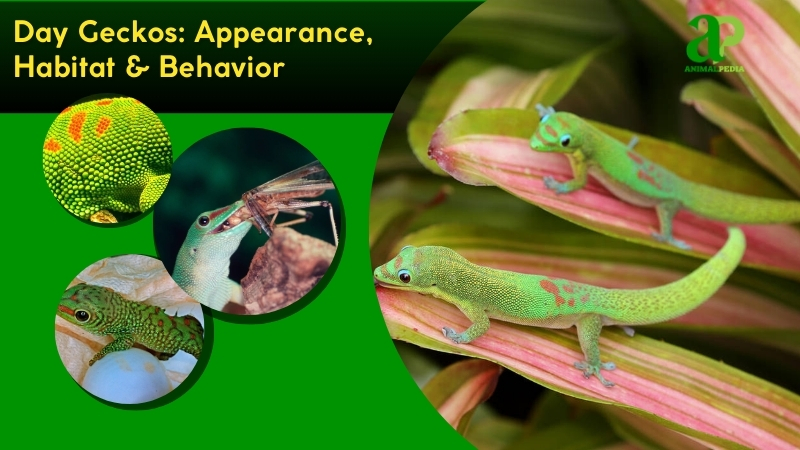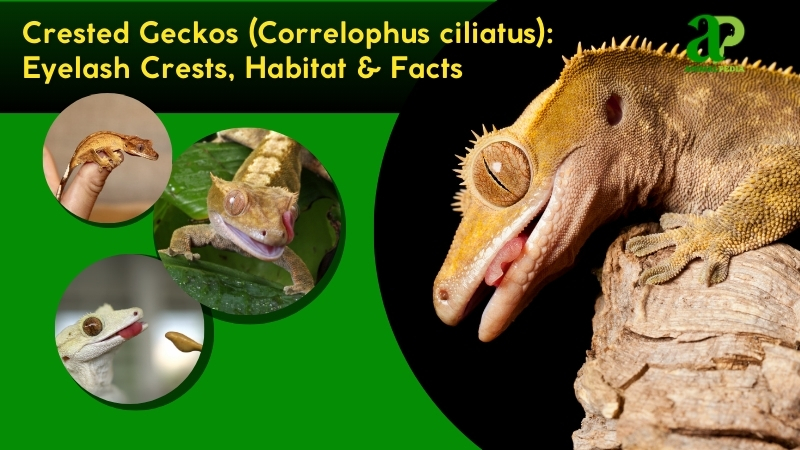Gargoyle geckos (Rhacodactylus auriculatus) are a species of lizard endemic to the tropical rainforests and shrublands of New Caledonia. They are members of the Diplodactylidae family, an order of scaled reptiles commonly referred to as Squamata. With a stout body, adults typically measure 7-10 inches (18-25 cm) in total length and weigh between 1.4-2.1 ounces (40-60 grams).
The species is distinguished by the bony knobs above its eyes, which give the head a spiny appearance, leading to its common names, including New Caledonian bumpy gecko and knob-headed gecko. These omnivorous, arboreal reptiles are primarily active at night, utilizing their climbing and jumping abilities to navigate the forest canopy. The species’ conservation status is listed as Near Threatened by the IUCN (25).
This guide examines the unique biological makeup and ecological role of this reptile. We consider how its distinct physical attributes, from its textured skin to its prehensile tail, allow it to survive in its native habitat.
A comprehensive analysis of the gargoyle gecko’s classification, physical characteristics, habitat, and behavior provides a thorough overview of this fascinating creature. What does it take for a gecko to thrive in a competitive, arboreal ecosystem? A complete understanding of the animal’s natural history and adaptations will provide the answers.
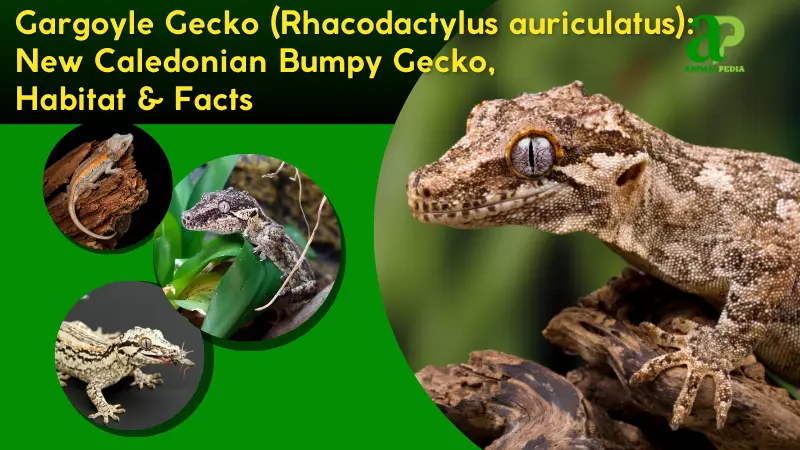
What Are Gargoyle Geckos?
Gargoyle geckos, scientifically known as Rhacodactylus auriculatus, are a lizard species endemic to New Caledonia, characterized by a distinctive crest of bony knobs on their heads and a crepuscular, arboreal lifestyle. Their taxonomic classification places them within the Diplodactylidae family, a group of geckos native to the New Caledonian region. They belong to the broader order Squamata, encompassing all scaled reptiles, and are members of the class Reptilia.
The species’ scientific name is a reference to its physical traits; “rhaco” and “daktylos” are Greek for “rag” and “finger,” respectively, referring to its wrinkled skin and toes, while “auriculatus” is a Latin term for “eared,” a direct nod to the distinctive projections on its head. This species is also referred to as the New Caledonian bumpy gecko or the knob-headed gecko, names that arise directly from its bumpy skin texture and the prominent knobs on its head.
The Gargoyle gecko is a reptile, a classification that places it alongside snakes, turtles, and crocodiles. Within the Gekkonidae family, the Gargoyle gecko has taxonomic relatives, such as the Crested gecko, a similar species from the same region.
Recent scientific literature confirms a stable taxonomic placement for Rhacodactylus auriculatus, with historical debates on its genus placement now resolved through phylogenomic analyses. This consensus avoids major scientific controversies regarding the species’ classification. Minor discussions exist regarding the exact extent of its dietary habits, but these are not considered contentious and are supported by field observations.
A detailed understanding of the Gargoyle gecko’s appearance and morphology is essential to fully appreciate its adaptations. How do its physical characteristics aid in its survival? The animal’s unique body shape, skin, and specialized structures directly relate to its arboreal behavior and ability to evade predators.
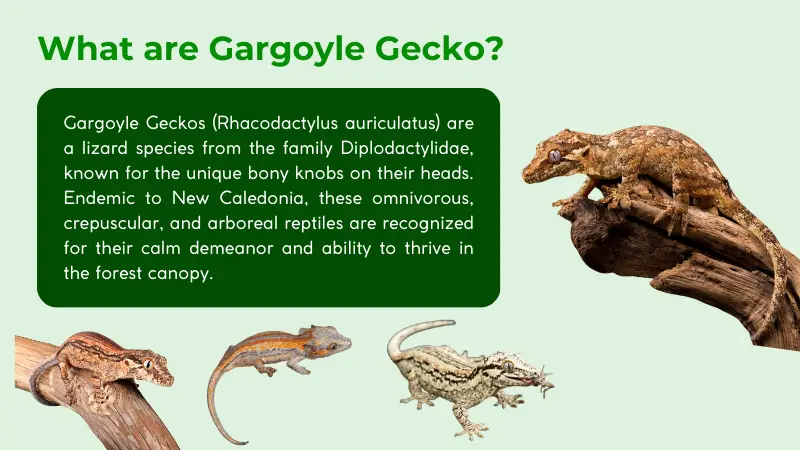
What Do Gargoyle Geckos Look Like?
The gargoyle gecko’s appearance is defined by its robust, squat physique adapted for life in the trees. The skin is a coarse texture, adorned with unique coloration that ranges from grays, browns, and oranges to reds, often displaying patterns like stripes, spots, or mottling for effective camouflage.
This texture provides a defense mechanism against predators. The coloration can also “fire up” or “fire down,” a common behavior where the gecko’s skin darkens or lightens depending on its mood or temperature. The overall body shape is thick with a strong prehensile tail that is used for grasping and balancing on branches.
The Gargoyle gecko has several key physical characteristics that distinguish it from related species. The most prominent are its head and tail morphology, which are integral to its survival.
- Distinctive Cranial Knobs: The most distinct feature is the pair of bony protrusions above the eyes, resembling horns. These cranial knobs may serve functions beyond mere aesthetics, possibly aiding in thermoregulation or species recognition, and contribute to its common name (16, 21).
- Highly Adapted Nocturnal Eyes: The eyes are large and possess vertical pupils, a specific adaptation for nocturnal vision. Lacking eyelids, the gecko uses its long, fleshy tongue to clean its eyes (21).
- Multi-functional Prehensile Tail: The tail is flattened, prehensile, and serves multiple functions, including balance, grasping, and fat storage. The tail can be shed through a process called autotomy when threatened by a predator, but it will only partially regenerate (23).
- Robust Climbing Limbs and Digits: The gecko’s limbs are relatively short and equipped with claws for gripping. Unlike other geckos that use adhesive toe pads, the gargoyle gecko relies on its claws for climbing, which is suited for the rugged bark of New Caledonia’s trees.
- Sturdy Jaw and Conical Teeth: The jaw is sturdy and holds numerous small, conical teeth designed for tearing soft fruits and insects, reflecting its omnivorous diet.
While the overall body size is similar between sexes, sexual dimorphism is present. Males can be distinguished by a visible hemipenal bulge at the base of their tail. Females may have a broader body shape, especially when gravid, but their coloration and primary physical features remain consistent with males.
Now that we know what a gargoyle gecko looks like, what about its size? The dimensions of this species directly influence its role in the ecosystem.
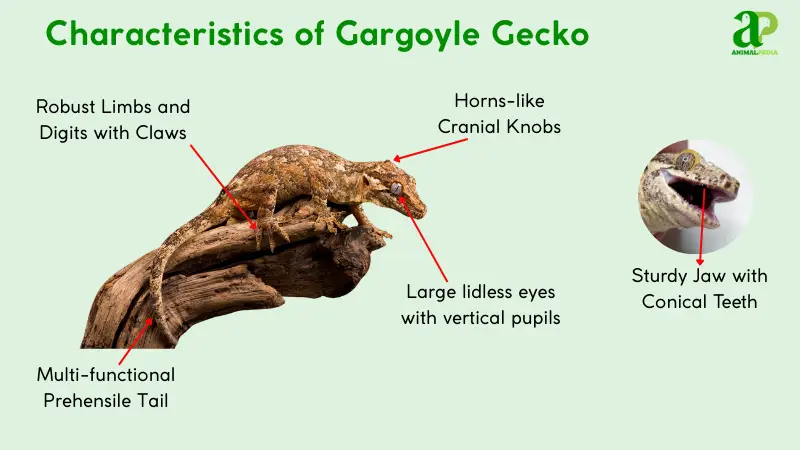
How Big Are Gargoyle Geckos?
Gargoyle geckos are a medium-sized reptile species, with adults reaching an average total length of 8-10 inches (20-25 cm) from snout to the end of the tail. Adult weight is typically between 1.2-2.1 ounces (35-60 grams), a weight comparable to a small avocado. Sexual dimorphism in size is present, with males being slightly heavier and females having broader bodies.
| Characteristic | Male | Female |
| Length | 8-10 inches (20-25 cm) | 8-10 inches (20-25 cm) |
| Weight | 1.4-2.1 ounces (40-60 grams) | 1.2-1.9 ounces (35-55 grams) |
| Record Size | up to 12 inches (30 cm) | up to 11 inches (28 cm) |
Gargoyle geckos undergo several growth stages. Hatchlings are small, measuring about 3 inches (7.6 cm) in length and weighing under 0.1 ounces (3 grams). Juveniles grow quickly, often reaching 5-6 inches (13-15 cm) by six months of age. They reach sexual maturity at approximately 15-18 months.
The size and physiology of this species are perfectly adapted for its home. Now, where exactly do these fascinating creatures live?
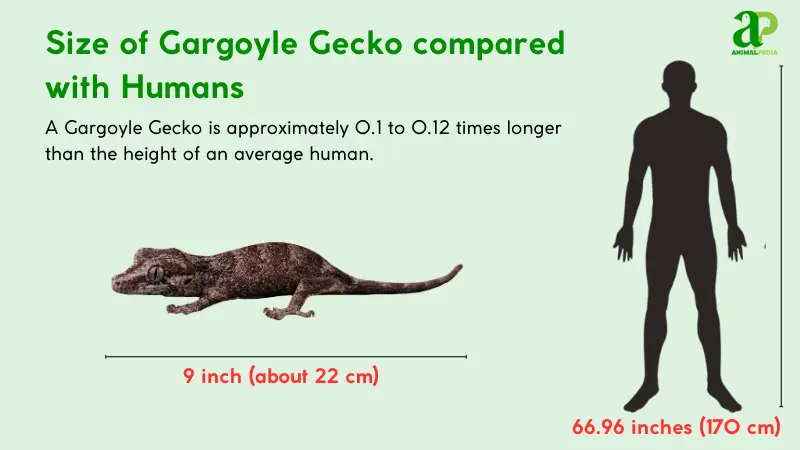
Where Do Gargoyle Geckos Live?
Gargoyle geckos are a species exclusively found in New Caledonia, a group of islands located in the southwest Pacific Ocean (19). This geographic isolation has resulted in unique adaptations for survival within their native biome.
The primary habitat of these geckos is the humid tropical forests and shrublands of New Caledonia, where they spend most of their time in the arboreal layer (5, 15). They are highly suited to the tropical climate, thriving at elevations up to 1,600 feet (500 meters) (15). While they do not establish rigid territories, they navigate and utilize home ranges for foraging and shelter.
Understanding their habitat is key to understanding their day-to-day actions. Let’s examine how these animals behave to survive and thrive in their environment.
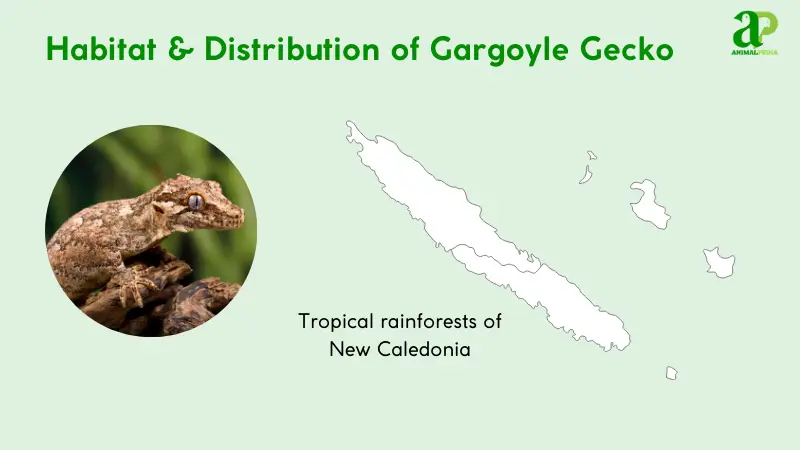
How Do Gargoyle Geckos Behave?
Gargoyle geckos are crepuscular, arboreal animals, with behaviors centered on an active nocturnal lifestyle, foraging, and predator avoidance. Their behavior is influenced by a diverse diet and specialized climbing abilities. They are known for their calm demeanor and can display a range of vocalizations.
- Diet and Feeding: Gargoyle geckos are omnivores that hunt a variety of insects and consume soft fruits in their native habitat.
- Movement and Abilities: These geckos use climbing and jumping to navigate the forest, relying on their claws and prehensile tails for agility.
- Daily/Seasonal Patterns: Their activity peaks during twilight hours, with behavior shifting to align with seasonal changes and food availability.
A deeper understanding of their day-to-day actions reveals how these geckos thrive in their natural environment. A closer look at their dietary habits shows how they find sustenance in the wild.
Diet and Feeding
Gargoyle geckos are omnivores that primarily eat insects and soft fruits. In their native habitat, this diet consists of invertebrates like crickets, roaches, and moths, complemented by ripe fruits, nectar, and pollen. They are ambush predators, waiting for prey to pass before striking quickly. These geckos have conical teeth designed to tear fruit and crush the exoskeletons of insects, reflecting their varied diet (4). Their feeding patterns are opportunistic, and they will consume whatever is most abundant. A varied diet provides the nutritional diversity necessary for their survival in a competitive ecosystem.
The way they eat is tied to how they move. How do these geckos navigate their world to find food and shelter?
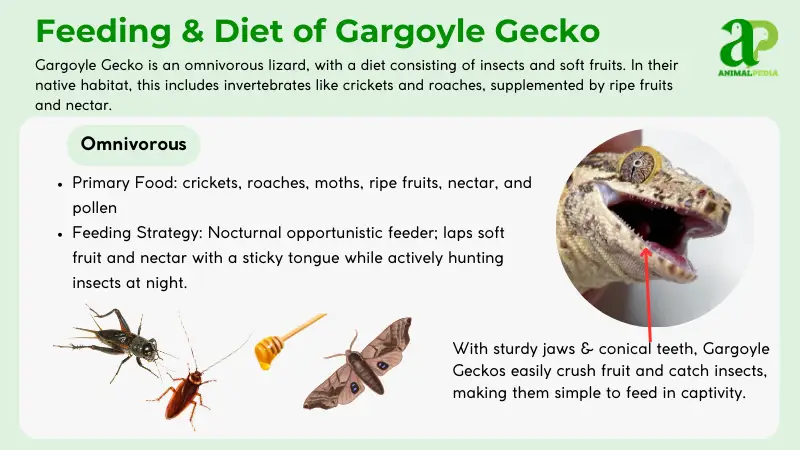
Movement and Abilities
Gargoyle geckos are agile climbers that move by walking, running, and jumping through the trees. They are well-adapted for an arboreal lifestyle, utilizing short, strong limbs with claws for gripping the rugged bark of New Caledonian trees. Their movement differs from that of geckos that rely on adhesive toe pads, making their climbing style more suited to their specific environment.
The geckos can perform controlled, directed jumps between branches, demonstrating their agility in the canopy (9). Their unique prehensile tail provides stability and a secure grip, functioning as a fifth limb for balancing and bracing. While not the fastest runners, their agility and climbing prowess give them a distinct advantage for both foraging and evading predators.
Their movement is dictated by their daily and seasonal cycles. When do these geckos wake up and go to sleep?
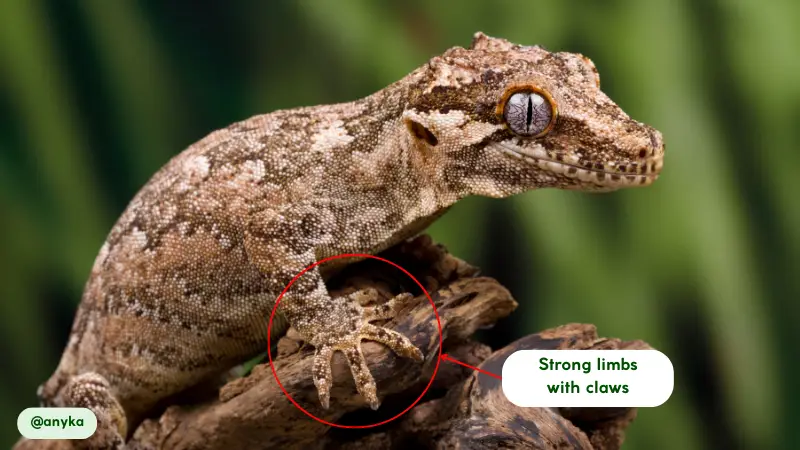
Daily/Seasonal Patterns
Gargoyle geckos are crepuscular, with their activity concentrated during the twilight hours of dawn and dusk. They follow a predictable daily activity cycle.
- Daytime: They are typically inactive, resting in concealed locations like tree hollows or under loose bark to avoid predators and heat (15).
- Twilight (Dusk): This is when they become active, leaving their hiding spots to begin foraging for food and seeking mates.
- Nighttime: They are most active during the night, hunting insects and consuming ripe fruits (5).
- Twilight (Dawn): Before sunrise, they return to their sheltered hiding spots for the day (5).
Their activity is also affected by seasonal changes. They are more active during the warmer, rainy season when food sources like insects and fruits are abundant. In contrast, their activity levels decrease during the cooler, drier months. Gargoyle geckos do not have a migratory period; they maintain a defined home range, typically moving within their local habitat to find food and shelter (15).
All of these behaviors are tied to the species’ survival, including how they create the next generation. What do we know about their reproductive habits?
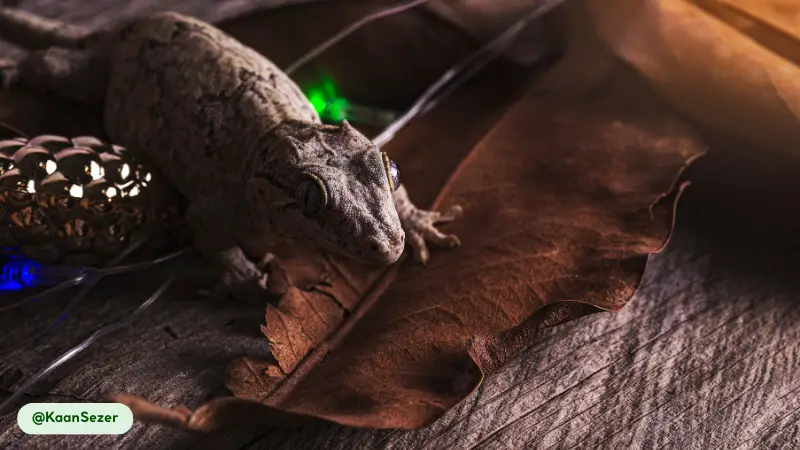
How Do Gargoyle Geckos Reproduce?
Gargoyle geckos are an oviparous species, meaning they reproduce through the laying of eggs. The mating season occurs during the warmer months, with a single female capable of producing up to ten clutches of eggs in a season (5). A female will lay two eggs per clutch, typically in a concealed location such as a hollowed log or buried in substrate.
Parental care is absent; the female departs after laying the eggs. The incubation period for the eggs lasts between 60 to 90 days, with the resulting hatchlings being fully independent upon emerging. Their reproductive cycle is directly tied to the availability of food and warm temperatures, allowing for the successful development of the eggs.
Their reproductive success is key to their long-term survival. What is the typical life expectancy of a gargoyle gecko?
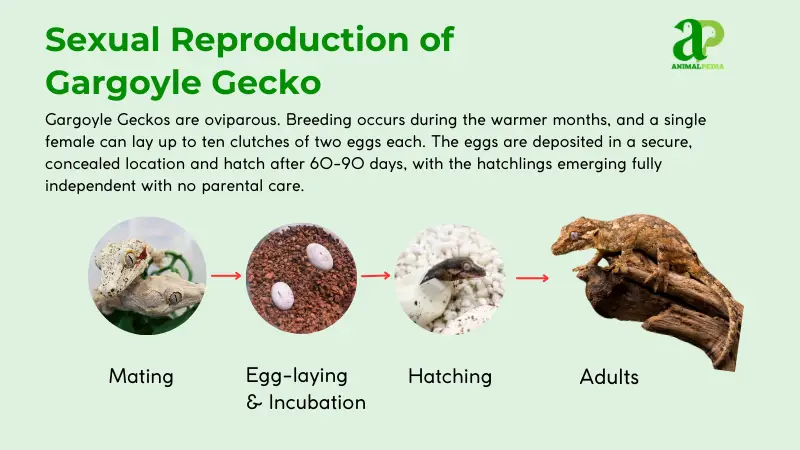
How Long Do Gargoyle Geckos Live?
Gargoyle geckos can live an average of 15 to 20 years in captivity, a significantly longer lifespan than their wild counterparts (5, 13). In their native habitat, longevity is reduced by factors such as predation, disease, and environmental fluctuations.
The controlled environment of captivity, with consistent nutrition and vet care, helps mitigate these threats. Gargoyle geckos reach sexual maturity at approximately 15 to 18 months, with full adult size attained around two years of age (11). This relatively fast growth rate allows them to reproduce early in their life cycle. Their overall longevity is influenced by factors like diet quality, stress levels, and habitat conditions.
These geckos are not only interesting animals to study, but they also have a direct impact on humans. How do they benefit us?
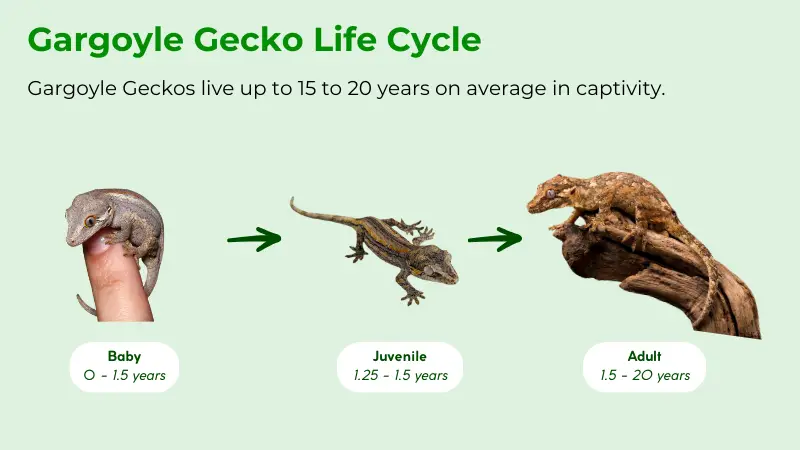
Are Gargoyle Geckos Beneficial to Humans?
In their native environment, gargoyle geckos are beneficial as they help regulate insect populations as a natural predator. Their primary benefit to humans is through their popularity as a pet. Their docile temperament, unique appearance, and relative ease of care make them a sought-after reptile for enthusiasts globally.
Besides, Gargoyle geckos are non-venomous, and their bites are not considered medically significant (18). These geckos primarily exhibit defensive behaviors like vocalizations, hissing, and puffing up their bodies to appear larger. They will only bite if they feel severely threatened or cornered, a behavior that is not an act of aggression but a final defensive measure (13).
Beyond their role in the pet trade, what is the gargoyle gecko’s conservation status in the wild? Are they currently at risk?
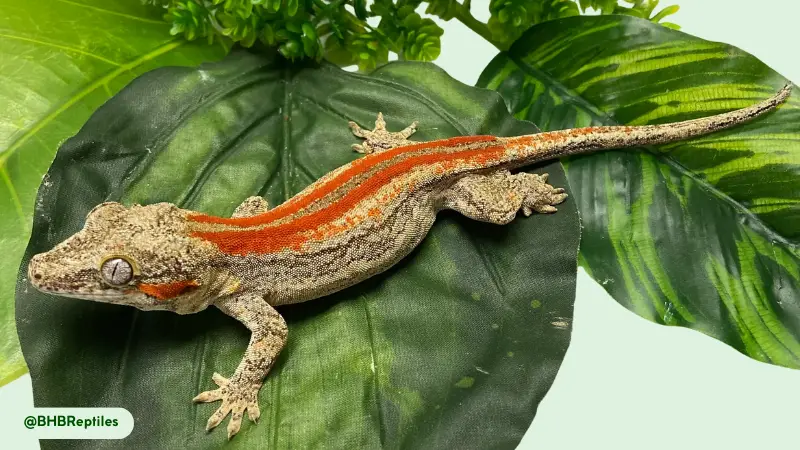
Are Gargoyle Geckos Endangered?
The gargoyle gecko is not currently classified as an endangered species; its conservation status is listed as Near Threatened (NT) on the IUCN Red List of Threatened Species (25). This designation means the species is close to being classified as threatened with extinction in the near future.
Primary threats to wild populations are habitat loss from deforestation and the effects of illegal collection for the pet trade. As an insectivore and frugivore, the gecko holds a significant ecological role, aiding in the control of insect populations and the dispersal of seeds, which helps maintain the health of the New Caledonian rainforest ecosystem.
Individuals can support the survival of these reptiles through several actions. These include advocating for the preservation of New Caledonia’s rainforests and supporting conservation organizations that work to protect endemic species. Sourcing captive-bred animals from reputable breeders is also vital, as this action reduces the demand for wild-caught geckos and helps curb illegal poaching.
Although there are no specific, widespread conservation success examples with associated percentages, the species’ ability to thrive in captivity has helped reduce demand for wild-caught specimens. This contributes to the species’ overall survival.
Now that we have covered the key aspects of this species, what are some unique and fascinating facts about them? Their unusual biology holds many surprises.
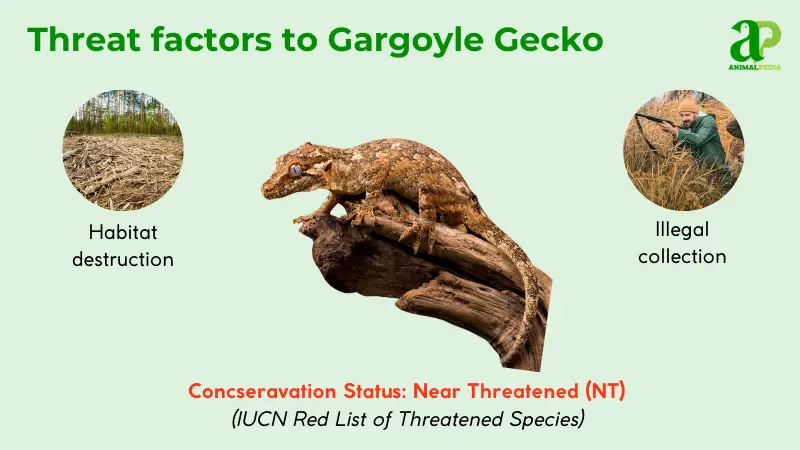
Frequently Asked Questions About Gargoyle Geckos
Are Gargoyle Geckos Good Pets?
Gargoyle geckos are considered excellent pets for reptile keepers of all experience levels due to their docile temperament and straightforward care needs (13). Their arboreal habits and interesting behaviors make them a visually engaging addition to a home environment.
Are Gargoyle Geckos Bigger Than Crested Geckos?
Gargoyle geckos are typically similar in length to crested geckos but have a stockier build, making them appear more robust and heavier overall. While a crested gecko may be longer, a gargoyle gecko will likely be more substantial in weight.
Can Gargoyle Geckos Regrow Their Tails?
Yes, gargoyle geckos can regrow their tails through autotomy, but the regenerated tail is visually different from the original (23). The new tail is typically smoother and can lack the distinct bumpy texture and color patterns of the original appendage.
What Insects Do Gargoyle Geckos Eat?
As omnivores, gargoyle geckos consume a range of insects, including crickets, roaches, and mealworms (4). Their diet is supplemented with soft fruits, nectar, and commercially available gecko food to provide a balanced nutritional intake.
Why Do Gargoyle Geckos Change Colors?
Gargoyle geckos change colors through a process called “firing up” or “firing down” in response to environmental factors and mood. The intensity of their coloration can shift based on light, temperature, stress, and excitement (13).
Do Gargoyle Geckos Lose Their Tails?
Gargoyle geckos will lose their tails as a defensive mechanism when feeling threatened or stressed. This process, known as autotomy, is a last resort to distract a predator and allow the gecko to escape (13).
Do Gargoyle Geckos Sleep With Their Eyes Open?
Gargoyle geckos do not have eyelids, so they cannot close their eyes (21). They appear to sleep with their eyes open, with a fleshy membrane covering the eyeball for protection.
Conclusion
The gargoyle gecko stands out as a unique reptile due to its distinctive appearance, adaptable behaviors, and crucial ecological function. From its arboreal lifestyle to its surprising vocalizations and defense mechanisms, every aspect of this species showcases a remarkable evolutionary history.
This information on Rhacodactylus auriculatus is an example of the kind of in-depth content you can find at Animal Pedia. We are dedicated to providing scientifically accurate information through a visually engaging format. We invite you to explore our digital encyclopedia further to learn about other amazing animals and their roles in the natural world.

